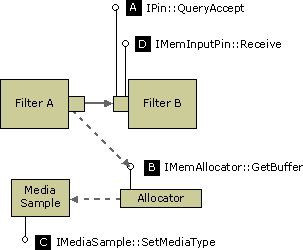
| Microsoft DirectX 9.0 |
This mechanism enables an output pin to propose a new format to its downstream peer. The new format must not require a larger buffer size. The output pin does the following:

All pins support the QueryAccept method. However, this method is slightly ambiguous, because a return value of S_OK does not always guarantee that you can change the format while the graph is active. Some filters might return S_OK but reject the change if the graph is active. The DynamicQueryAccept method, which is supported by some input pins, explicitly defines S_OK to mean the pin can change formats while active. If an input pin supports the IPinConnection interface, you should call DynamicQueryAccept rather than QueryAccept.
In most cases, this mechanism does not allow for drastic changes to the format, such as changing the bit depth. One situation in which it can be used is when a video decoder switches palettes. The basic details of the format stay the same, such as the image dimensions and the bit depth, but the new media type has a different set of palette entries.
Implementation Note
In the DirectShow base classes, CBasePin::QueryAccept calls the CheckMediaType method, which is also called during the initial pin connection. In the case of a transform filter, the input pin's CheckMediaType method should always check whether the output pin is connected, and if so, whether the input media type is compatible with the output media type. Therefore, this implementation will likely be valid for QueryAccept. If not, you should override QueryAccept in order to perform any additional checks that are needed. Also, note that the CTransformFilter class encapsulates this logic within the CheckInputType and CheckTransform methods. The CTransInPlaceFilter class, on the other hand, always calls QueryAccept on the next upstream or downstream filter.
The CBaseInputPin::Receive method checks for a media type on the incoming sample, and if there is one, calls CheckMediaType. However, it does not update the pin's m_mt member, which holds the current media type. When your filter processes the sample, you should check the sample for a media type. If there is a new type, you will probably need to store it, either by calling SetMediaType on your pin or by setting the value of m_mt directly. On the other hand, the CVideoTransformFilter class, which is designed for video transform filters, stores the media type when it changes. For details, see the source code for CVideoTransformFilter::Receive in the DirectShow base class library.
In some cases, you might simply pass the QueryAccept call downstream, then attach the media type to the output sample and let the downstream filter handle the format change.